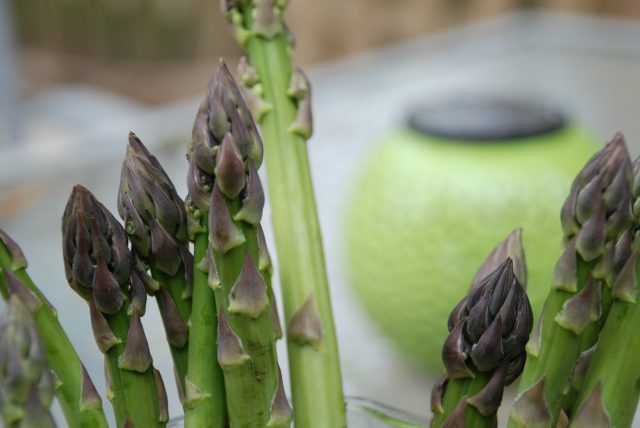Asparagus is now

Asparagus is a harbinger of summer, a clarion that winter is well and truly over and early produce — ramps, fiddleheads, morels, rhubarb — are ready. The early stalks are a beautiful apple-green with a tip tinged with purple.
The earlier in the season, the sweeter the asparagus: the stalks grow from underground rhizomes and, because they must be picked by hand, it helps explain the vegetable’s price at times.
Eat often and eat early: as the season rolls through its prime months of May and June and approaches July, the rhizomes begin to weaken and become depleted leaving the asparagus less flavourful.
The ancient Romans loved it and centuries later chefs created cooking vessels which kept the thicker stalks submerged in the cooking liquid while leaving the delicate tips above water to be steamed.

You’ll also find historic and inventive serving bowls designed for the shape of asparagus which had hollow sides that were filled with boiling water to keep the freshly cooked asparagus warm.
Try it with a healthy drizzling of beurre noisette and its hazelnut flavour and colour; or, as asparagi alla Parmigiana, an authentic dish of Emilia-Romagna: cooked asparagus tips are sprinkled generously with Parmesan cheese and melted butter.
In Tuscany, asparagus soup is made with saffron, pine nuts and pistachios.
To trim up your asparagus, gently bend the stalk with fingers holding opposite ends aiming for the point where woody and tender meet, and snap it off. You can finish the preparation by shaving the woody end with a harp peeler to create a more uniform size for cooking.
This tender crop loses its freshness very quickly – in a matter of hours, actually, and more rapidly than other vegetables, especially in the first 24 hours. Store asparagus cool and away from light. The stalk continues to draw on its sugars becoming tougher and less juicy.
To re-invigorate it before cooking, give it some sweetness: add about a teaspoon of sugar to a half-cup of water and soak the asparagus before cooking.

In terms of other ways to serve asparagus, simple is often best. You can do the Julius Caesar trick: just prepare the asparagus spears with a dose of melted butter, as he liked it. Adding a bit of fennel to the butter gives a lovely anise flavour to the dish.
Grill raw asparagus with a liberal salting and peppering along with a squeeze of lemon, a few glugs of some good olive oil and perhaps shavings of Parmesan cheese. Grill the spears in batches according to their diameter for even cooking.
When the season is moving toward its close, a classic cream of asparagus soup may be in order; garnish it with the delicate tips and a drizzle of cream or olive oil to present it simply and beautifully.
Another classic, asparagus Polonaise, is hot asparagus dressed with hard-boiled egg yolk that has been passed through a fine-meshed sieve and drizzled with melted butter and golden-toasted breadcrumbs.
An omelette with fresh asparagus is delicious for breakfast.
As a salad, mix grilled asparagus pieces with a bit of pesto, Parmesan, and perhaps some slices of smoked salmon. Toss with olive oil, lemon juice, a few croutons and top with a sunny-side up egg. Garnish with Parmesan shavings.
While fresh is best, remember that asparagus is remarkable as a preserve, so consider a quick pickle. Put together a mix of vinegars with about 100 grams of sugar per litre of liquid. Add peppers, spices, herbs like tarragon or rosemary and garlic. Boil the mixture, pour it over the asparagus in jars and store in the fridge.
You’ll be able to enjoy the local asparagus of May when it’s long past asparagus seasons.

